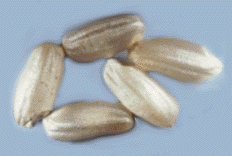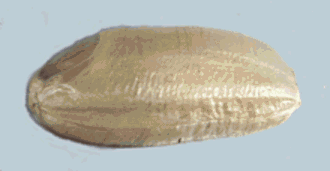Rice grains can exhibit large variations with respect
to differing varieties. Anatomically, rice grains vary in the grain length,
grain shape, translucency and the chalkiness. Many of the other variations
in rice plant, and the rice grain specifically, involve genetic differences
which are not always anatomically noticeable, such as pest resistance or
temperature tolerance. Additionally, certain grain qualities are actively
bred for by the crop community to enhance the ability to harvest rice.

Grain length and shape are simple, visual ways of
categorizing the rice grains based on their relative size. The grain length
can be categorized as extra long (over 7.0 mm), long (between 6.0-6.99
mm), medium (between 5.0-5.99 mm) and short (less than 5.0 mm). The grain
shape refers to the grain length to width ratio; and are categorized as
slender (ratio greater than 3.0), medium (ratio between 2.1-3.0), bold
(ratio between 1.1-2.0) and round (ratio less than 1.1). These guidelines
are not exact, there is variation among the rice community as to an exact
scale with which to judge the rice grains. "Grain length and shape are
quantitatively inherited. the F1 is typically intermediate between its
parents in size...grain size is highly heritable in most environments although
low temperature after flowering can slightly reduce grain length." (Jennings,
1979; pg. 104)

To learn more about the internal anatomy of the rice grain,
visit the grain anatomy page.
The grain translucency and chalkiness refer to the
visual characteristics of the grain. Translucency is the color of the
endosperm. It is rated as clear, intermediate or opaque. The chalkiness
refers to the presence or absence of a white belly, white center or white
back. These terms are often grouped under the simple title of white belly.
the presence of a white belly in the rice grain is due partially to the
genetic makeup of the variety, but is also due to the "temperature immediately
after flowering; high temperature increases white belly while low temperature
decreases or eliminates it." (Jennings, 79: pg. 101) The environmental
effect can distinctly alter the interpretation of the chalkiness of the
grain not due to the genetic makeup of the plant species.
